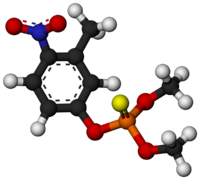Fenitrothion
This article may be unbalanced towards certain viewpoints. (August 2018) |

| |

| |
| Names | |
|---|---|
| Preferred IUPAC name
O,O-Dimethyl O-(3-methyl-4-nitrophenyl) phosphorothioate | |
| Other names
• Dimethoxy-(3-methyl-4-nitrophenoxy)thioxophosphorane
O,O-Dimethyl O-4-nitro-m-tolyl phosphorothioate | |
| Identifiers | |
3D model (
JSmol ) |
|
| ChEBI | |
| ChEMBL | |
| ChemSpider | |
ECHA InfoCard
|
100.004.114 |
| KEGG | |
PubChem CID
|
|
| UNII | |
CompTox Dashboard (EPA)
|
|
| |
| |
| Properties | |
| C9H12NO5PS | |
| Molar mass | 277.23 g·mol−1 |
| Appearance | Yellow-brown liquid |
| Density | 1.3227 g/cm3 |
| Melting point | 3.4 °C (38.1 °F; 276.5 K) |
| Boiling point | 118 °C (244 °F; 391 K) at 0.05 mmHg |
| 38.0 mg/L | |
| Solubility | Readily soluble in dichloromethane, 2-propanol, toluene, hardly soluble in n-hexane.[1] |
| log P | 3.30 (octanol/water)[2] |
| Hazards | |
| Lethal dose or concentration (LD, LC): | |
LD50 (median dose)
|
Rat, oral: 500 mg/kg[3] Mouse (female), oral: 1416 mg/kg[4] |
Except where otherwise noted, data are given for materials in their standard state (at 25 °C [77 °F], 100 kPa).
| |
Fenitrothion (
Health effects
This section needs more primary sources. (August 2018) |  |
Fenitrothion at sublethal doses affected the motor movement of marsupials,[6] and at acute dose levels it reduced the energy of birds.[7]
In chronic (low) dose tests, unexpectedly only the lowest concentration (0.011 microgram/liter) of fenitrothion depressed the growth of an algae, though all of the chronic dose levels used were toxic in other ways to the algae.[8]
Just half of fenitrothion's minimally effective dose altered the thyroid structure of a freshwater murrel (the snakehead fish).[9]
Cases of non-specific
2-day-old mice were dosed topically for 11 days with fenitrothion, amongst other substances. After a further 2 days a sublethal dose of
encephalomyocarditis virus was injected subcutaneously in known titre. Mortality-rates in the 10-day period after virusinjection 4-9% in fenitrothion groups, and 0% in corn-oil controls. Fatty changes were noted in liver and kidney in the insecticide-virus groups. The encephalopathy showed no specific central-nervous system lesion, but death followed a sequence of paralysis and convulsions. The possible role of exposure to combinations of insecticides in human viral susceptibility requires further attention.
Further study showed that the illness was caused not by fenitrothion itself, but combinations which included the surfactants and the solvent (with or without the pesticide) clearly showed that pretreatment with these chemicals markedly increased the viral lethality in the test mice.[12]
Resistance
In an unusual demonstration of resistance to pesticides, 8% of insects in farm fields were found to carry a symbiotic gut microbe that can metabolize and detoxify fenitrothion; after in-vitro tests showed that the microbe significantly increased the survival of fenitrothion-treated insects.[13]
References
- OCLC 50201739.
- OCLC 924843801.
- OCLC 873939596.
- ^ Sekizawa J, Eto M, Miyamoto J, Matsuo M (1992). Environ Health Criteria 133: Fenitrothion (Report). Geneva: World Health Organization. p. 70.
- ^ "Fenitrothion". PubChem Compound Database. National Center for Biotechnology Information.
- PMID 18547601.
- PMID 21227481.
- PMID 8950533.
- PMID 15092506.
- PMID 179146.
- PMID 4134409.
- .
- PMID 22529384.
Further reading
- Folster D (14 May 1976). "Poison mists from pesticides in New Brunswick". Five Nights. CBC Radio.
External links
- Fenitrothion in the Pesticide Properties DataBase (PPDB)
- Hazardous Substances Data Bank (source of data)
- Inchem
- Entox
- Re-evaluation of Fenitrothion by the Pest Management Regulatory Agency of Canada
